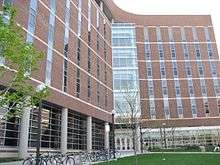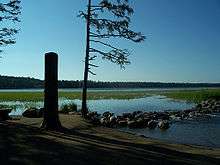University of Minnesota College of Biological Sciences
The College of Biological Sciences (CBS) is one of seven freshman-admitting colleges at the University of Minnesota. Established in 1869 as the College of Sciences, the College of Biological Sciences is now located on both the Minneapolis Campus and the St. Paul Campus. CBS is a college that focuses its undergraduate and graduate attention towards research. The dean is Valery E. Forbes. The Associate Dean for Graduate Education is Carrie Wilmot, the Associate Dean for Undergraduate Education is John Ward, the Associate Dean for Research is David Greenstein, and the Associate Dean for Faculty is Marlene Zuk.[1]
 | |
| Type | Public |
|---|---|
| Established | 1869 |
| Dean | Valery E. Forbes |
Academic staff | 139 tenured and tenure-track faculty members |
| Students | 2,338 students (2,075 Undergraduate; 259 Graduate; 4 Non-Degree) |
| Location | Minneapolis and St. Paul , MN, , |
| Campus | Urban |
| Website | www.cbs.umn.edu |
Institution

The College of Biological Sciences at the University of Minnesota is one of the few colleges nationwide devoted to biological sciences. CBS explores a world of opportunities, from molecules to ecosystems, to improve human health, develop renewable resources, enhance agriculture, and restore the environment. College of Biological Science undergraduates are among the most qualified at the University of Minnesota. The 2008 incoming freshman class, on average, had the highest class rank and ACT scores of any college within the university system.[2]
There were 1,789 undergraduates registered for the fall of 2006 and 82 percent graduated in the top 15 percent of their high school class. There were a total of 377 freshmen and 135 faculty members many of which are known for their excellence with 4 of them being in the National Academy of Sciences.
CBS Faculty conduct basic research on a range of applications in human health, agriculture, biotechnology and environmental sciences.
History
In 1887, the Animal Science Department was established in the College of Science, Letters, and Arts. In 1927, it was renamed Zoology. Then in 1891, the Botany Department was created. Eight years later, Lake Itasca Forestry and Biological Station was established with a forestry training program. It is now the site for the "Nature of Life" program CBS students must attend for 4 days in the summer before their freshman year. Then the Agricultural Biochemistry Department was formed within the Institute of Agriculture. In 1928, Snyder Hall, named for agricultural scientist Harry Snyder, was built to house Agricultural Biochemistry. Snyder Hall is now the headquarters for CBS, located on the St. Paul campus. In 1973, the Biological Sciences Center was built to house the Botany department and the Genetics and Cell Biology Department.[3]
In 1993, the Ecology Building was constructed on the St. Paul campus. Two years later, administration of the Bell Museum was transferred to the College of Natural Resources. In 1998, Dean Robert Elde led a university-wide reorganization to consolidate and realign departments in order to strengthen biological sciences and raise the university's national standing. The College of Biological Sciences’ (CBS) current structure grew out of that effort.[3]
In 2001, Biodale opened, offering biological research support services to faculty, students, and industry. It is currently one of the most used resource on campus. Then in 2004, University Enterprise Laboratories, Inc. was dedicated. Founding sponsors included Xcel Energy, the City of St. Paul, the University of Minnesota, 3M, Medtronic, Dorsey & Whitney, Surmodics, Guidant, Boston Scientific, and Ecolab.[4]
Structures
Administrative offices for the College of Biological Sciences are located in Snyder Hall, at 1475 Gortner Avenue on the St. Paul campus. These include the Dean's Office, Communications, and Alumni Relations. Student services are located in the Molecular and Cellular Biology Building at 420 Washington Avenue SE on the East Bank campus. The departments of Plant and Microbial Biology and Ecology, Evolution and Behavior are in adjacent buildings. The Cargill Building for Microbial and Plant Genomics is across the street. The Department of Biochemistry, Molecular Biology and Biophysics is located in Jackson Hall on the Minneapolis campus, and the Department of Genetics, Cell Biology and Development is in the Molecular and Cellular Biology Building on the Minneapolis Campus.
The Department of Biochemistry, Molecular Biology and Biophysics and the Department of Genetics, Cell Biology and Development are shared with the University of Minnesota Medical School. The Department of Plant and Microbial Biology is shared with the College of Food, Agricultural and Natural Resource Sciences (CFANS). The Department of Ecology, Evolution and Behavior remains exclusive to CBS with close ties to CFANS, which administers the Bell Museum of Natural History. The Department of Neuroscience and the Department of Microbiology—both part of the Medical School—are affiliated with CBS. The BioTechnology Institute is a joint effort of CBS and the Institute of Technology. CBS also operates two field stations—Cedar Creek Natural History Area, the birthplace of the modern science of ecosystem ecology, and Itasca Biological Station and Laboratories, used for education programs, field research, and public outreach.
Research facilities and fields
The College of Biological Sciences shares several research, education and outreach facilities.
Biodale, CBS’ one-stop shop for research support services, houses $40 million in bioscience research equipment that is available to faculty and industry scientists.[3]
The Cargill Building for Microbial and Plant Genomics provides a hub for genomics researchers university-wide. Faculty conduct basic research in functional genomics of microbes and crop plants to identify innovative ways to make crops more resistant to disease and drought, clean up the environment, and improve human health.
The Molecular and Cellular Biology Building opened in 2002 on the Minneapolis campus and houses classrooms and labs. It is home to the Department of Biochemistry, Molecular Biology, and Biophysics and the Department of Genetics, Cell Biology, and Development.

University Enterprise Laboratories (UEL) is a non-profit entity that provides lab space for biotech start-up companies. Sponsors include Xcel Energy, 3M, Allina, Medtronic, Boston Scientific, Dorsey & Whitney, Ecolab, Guidant Corporation, and Surmodics.
Itasca Biological Station and Laboratories established in 1909, houses many buildings for research as well as the summer portion of the freshman program, "Nature of Life" which all incoming CBS freshman must attend before entering their first year at the university. This portion of Nature of Life prepares students for the upcoming year and gives them an idea of one of the research facilities provided by CBS and the university. The program continues for the next 4 semesters, during which each enrolled student is expected to fully immerse themselves into CBS and university-wide events and communities.[5]
Other research facilities include Cedar Creek Ecosystem Science Reserve, the Ecology Building, Plant Growth Facilities such as the CBS Conservatory and Botanical Collection, and Snyder Hall/Gortner Laboratories/Biological Sciences Center complex.
Notable faculty and staff
In 1995, Edward B. Lewis (B.S. '39) received the Nobel Prize in Physiology or Medicine for discovery of the collinearity principle in fruit flies, which revealed that the linear arrangement of genes on a chromosome corresponds to the development of body segments. The finding was later confirmed in humans.
Then in 1997, Paul D. Boyer won the Nobel Prize in Chemistry for discovering how cells make adenosine triphosphate (ATP). Boyer was on the faculty of the biochemistry department from 1945–1957.
G. David Tilman is the current director of Cedar Creek Ecosystem Science Reserve and member of the National Academy of Sciences. He is currently the most cited ecologist in the Web of Science[6]
Majors offered
- Biochemistry (BIOC)
- Biology (BIOL)
- Ecology, Evolution, and Behavior (EEB)
- Genetics, Cell Biology, and Development (GCD)
- Microbiology (MICB)
- Neuroscience (NSC)
- Plant and Microbial Biology (PMB)[7]
- Cellular and Organismal Physiology (COP)[8]
Minors[9]
- Behavioral Biology
- Biochemistry
- Biology
- Cellular and Molecular Neuroscience
- Computational Biology
- Integrative Neuroscience
- Plant Biology
- Marine Biology
- Microbiology
- Pharmacology
Graduate programs
- Biochemistry, Molecular Biology, and Biophysics (BMBB)
- Ecology, Evolution and Behavior (EEB)
- Molecular, Cellular, Developmental Biology, and Genetics (MCDB&G)
- Plant Biological Sciences
Research projects
In addition to the Nobel Prize winners for Physiology and biochemistry, other important research projects have been conducted by the university and CBS. Being a research based college, faculty and students often take advantage of plentiful opportunities to research a variety of topics.[10]
Grants
Funding is needed for all projects. One recently was the 2.8 million dollar grant from the National Science Foundation which supported interdisciplinary training for ecologists and civil engineers. This grant was used to train graduate students in ecology, civil engineering, and geology to study the combined effects of physical and biological changes on environmental quality, in particular the Mississippi River watershed.[11]
Another grant was the $8.5 million grant from the Initiative for Renewable Energy and the Environment(IREE). Projects included bio-energy and bio-products; economic and policy assessments; production and distribution of hydrogen; carbon sequestration; Nanotechnology; solar thermal heating systems; and conversion of livestock waste to energy and products. They awarded this grant to 24 renewable energy projects at the university in August 2006, including CBS.[11]
Student Involvement
CBS Students are not only heavily involved with their classes, but also in many different student organizations related to the biological sciences. Administrative sponsored student clubs include:
- CBS Student Board
- CBS Ambassadors
- Deans' Scholars Program
- CBS Circles
University of Minnesota students also have the opportunity to create their own student groups.[12] Examples of these student started groups include:
- AED Pre-Medical Honor Society
- AMSA Premed
- Biochemistry Club
- Biological Science Research Club
- Biology Without Borders
- Brain Club
- Ecology, Evolution, and Behavior Club
- Forensic Science Club
- Future Leaders Aspiring in Science and Healthcare
- Genetics, Cell Biology, and Development Club
- Health and Biological Research News Club
- Inter-Professional Pre-Health Students
- Marine Biology Club
- Microbiology Club
- Microbiota in Health and Medicine Interest Group
- Minnesota Medical Leaders
- Minnesota Science and Business Association
- Minority Association of Pre-Medical Students
- MSTEM
- Pharmacology Club
- Pre-Dental Club
- Pre-Genetic Counseling Club
- Pre-Meds in Action
- Pre-Occupational Therapy Group
- Pre-Optometry Club
- Pre-Pharmacy Club
- Pre-Physical Therapy Club
- Pre-Physician Assistant Organization
- Pre-Veterinary Club
- Student Society of Stem Cell Research Club[13]
- Synthetic Biology Society
- Undergraduate Public Health Association
- Undergraduate Surgery Interest Group
Footnotes
- "College Leadership". College of Biological Science. Retrieved 1 March 2019.
- http://admissions.tc.umn.edu/academics/profile.html
- University of Minnesota, College of Biological Sciences
-
- "A Smart Start For Bioscience", St. Paul Pioneer Press, October 10, 2004:sec. B10
- "The Wildest Classroom in Minnesota, Itasca Biological Station and Laboratories, http://cbs.umn.edu/itasca/
- Davis, Tinsley (2004). "Biography of David Tilman". Proceedings of the National Academy of Sciences of the United States of America. 101 (30): 10851–3. doi:10.1073/pnas.0404605101. PMC 503709. PMID 15263082.
- University Catalogs
- "CBS Introduces Cellular and Organismal Physiology Major | College of Biological Sciences". cbs.umn.edu. Retrieved 2019-02-04.
- "CBS Minors".
- "UNIVERSITY OF MINNESOTA, U.S.;Researchers from University of Minnesota, U.S., report recent findings". March 17, 2007
- Greg Breining, Mary Hoff, Terri Peterson Smith, Peggy Rinard, "Star Search", College of Biological Science BIO, Vol 4 No. 2, Fall 2005
- "Student Groups". Student Unions & Activities. University of Minnesota. Retrieved 30 April 2015.
- University of Minnesota, College of Biological Sciences
See also
- University of Minnesota
- List of University of Minnesota people
- University of Minnesota Medical Center
References
- "UNIVERSITY OF MINNESOTA, U.S.;Researchers from University of Minnesota, U.S., report recent findings".17 March 2007
- "A Smart Start For Bioscience", St. Paul Pioneer Press, 10 October 2004: B10
- Breining Greg, Hoff Mary, Peterson Smith Terri, Rinard Peggy, "Star Search", College of Biological Science BIO, Fall 2005, Vol 4 No.2
- "The Wildest Classroom in Minnesota." Itasca Biological Station and Laboratories. 26 Mar. 2007. Regents of the University of Minnesota. 7 May 2007.<http://cbs.umn.edu/itasca/>
- University of Minnesota, College of Biological Sciences
- University Catalogs